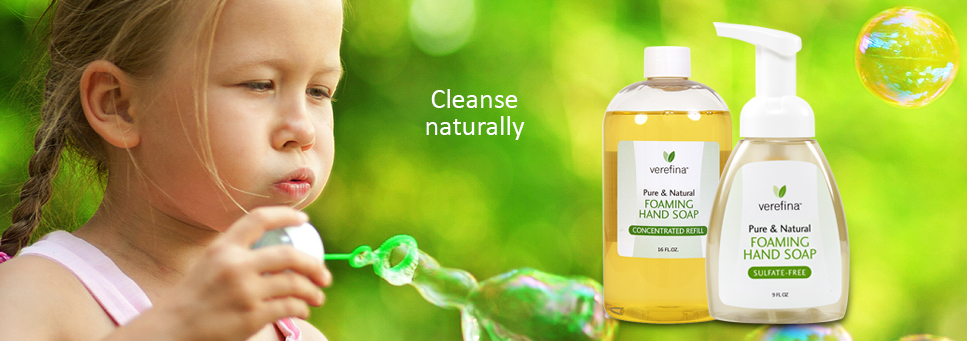Top 5 Benefits of Verefina's Soaps
Posted by Katie Zapotoczny on 25th Feb 2016

There is a wide variety of hand soaps available to customers today. Not all soaps are created equal, though. Many commercial soaps contribute to dry, irritated skin or contain unnecessary and even toxic ingredients. In contrast, Verefina’s soaps are hand-crafted with 100% natural ingredients that contribute to overall good health. Here are the top five benefits of using Verefina’s soaps.
Verefina Soaps Won’t Cause Irritation
Many skin irritations like itchiness, flaking, and redness are a result of dry skin, which can be caused by hand washing. Verefina’s Foaming Hand Soap doesn’t dry skin like many other soaps do. Our Hand Soap is what is known as a Castile soap. The process of making Castile soap is a traditional one that originated in the Castile region of Spain. This process involves reacting a plant oil with a lye solution. Glycerin is created as a byproduct of this reaction. Frequently, glycerin is removed during the production process. However at Verefina, we leave the glycerine in because it helps moisturize the skin, allowing your skin to be hydrated with every use. The Shea Butter Bar Soap is excellent for irritated skin as well. The coconut oil and shea and cocoa butters in this bar moisturize the skin.
Verefina Soaps are Good for Skin Conditions/Sensitivities
People with eczema, psoriasis, dermatitis, and sodium lauryl sulfate sensitivities often have a hard time finding skincare products that won’t irritate their skin or worsen their conditions. Verefina's soaps- including those for children and babies- provide a great solution for these conditions because they are very gentle on the skin and can improve overall skin health.
Many soaps (and other personal care products) contain foaming agents such as sodium lauryl sulfate and sodium laureth sulfate that strip the skin of its natural oils and increase its permeability, weakening the defensive barrier that the skin is meant to provide for the body. Verefina’s soaps are completely free of such toxic synthetic ingredients and deliver healing nutrients to the skin. The Shea Butter Bar Soap, for example, contains cocoa butter and aloe vera juice. Cocoa butter can help form a protective barrier on the skin, so it may help with problems such as dermatitis (source). Aloe vera juice contains high levels of vitamins, minerals, and amino acids that help nourish the skin. Using one of Verefina’s three lotions after washing with the Shea Butter Bar can help lock moisture into the skin and prevent irritation. Aloe and Calendula Cream is particularly well-suited to address these conditions. Lavender and unscented lotions are best for those with extremely irritated skin.
Verefina Soaps Don’t Carry Health Risks
Commercial antibacterial soaps often contain a chemical called triclosan, which is registered as a pesticide by the EPA (source). Triclosan can contribute to bacterial resistance, endocrine system issues, and impaired muscle function. It can also accumulate in rivers and lakes, affecting wildlife. Verefina's soaps do NOT contain triclosan.
Verefina Soaps are Scented with Health-Promoting Essential Oils
Commercial soaps contain a variety of synthetic fragrances. These fragrances can contain dangerous neurotoxins and phthalates (for more information on artificial fragrances, see Why You Won’t Find These 5 Ingredients in Verefina Products). In contrast, Verefina's soaps are scented using health-promoting therapeutic grade essential oils and natural flavors. Essential oils are concentrated aromatic compounds derived from plants. Each essential oil contains a distinctive scent or “essence” of the plant from which it comes. Essential oils have a very small molecular size, which allows them to be absorbed into the skin and bloodstream and to positively affect cells within the body. Essential oils are fat-soluble molecules, so they are able to pass through the lipid (fatty) barrier surrounding cells. Once inside, they deliver oxygen and nutrients. Essential oils also help to detoxify the cells. As oxygen enters the cell, toxins and unwanted chemicals are forced out (source). Many essential oils, including lavender and lemon, have antimicrobial properties, so they can help eliminate germs on the hands. Essential oils are also commonly used for their aromatherapeutic benefits. Lavender essential oil, for example, is known for its calming, soothing effect, while citrus oils tend to have refreshing, uplifting scents.
Verefina Soaps are a Great Value
Verefina’s natural soaps are slightly more expensive than those made with synthetic ingredients, and contain only high-quality ingredients that are pure, natural, and SAFE. Our Foaming Hand Soap Concentrated Refill is an extremely economical option. One bottle of the concentrate refills a 9-oz. pump eight times! Commercial soaps use low-quality and potentially hazardous ingredients composed mainly of cheap chemicals, additives, and toxins.
With so many benefits to Verefina’s soaps, you’ll never go back to your old soap again!
Have you ever had a problem with or a reaction to a particular soap? Is there an all-natural soap that you love? Tell us about it.
Sources:
Callahan, Christy. “The Benefits of Pure Cocoa Butter.” LiveStrong. 16 August 2013. Web. 22 February 2016.
http://www.livestrong.com/article/200160-the-benefits-of-pure-cocoa-butter/
Eng, Monica. “Do Soaps with Triclosan do More Harm Than Good?” Chicago Tribune. 10 February 2013. Web. 22 February 2016.
Goldberg, Jane G. “More Than a Scent: Essential Oils Aid the Immune System.” Huffington Post. 9 June 2011. Web. 22 February 2016.
http://www.huffingtonpost.com/jane-g-goldberg-phd/essential-oils-health_b_868303.html
Malina, Chris. “Minnesota Bans Antibacterial Soap Ingredient.” Wisconsin Public Radio. 22 May 2014. Web. 22 February 2016.
http://www.wpr.org/minnesota-bans-antibacterial-soap-ingredient-triclosan
Martin, Andrew. “Triclosan, an Antibacterial Chemical, Raises Safety Issues.” The New York Times. 11 August 2011. Web. 22 February 2016.
“Triclosan.” United States Environmental Protection Agency. Web. 22 February 2016.
http://ofmpub.epa.gov/apex/pesticides/f?p=chemicalsearch:3:0::no:1,3,31,7,12,25:p3_xchemical_id:4124
Photo courtesy of Verefina
 About the Author
About the Author
Katie Zapotoczny is a Verefina Affiliate and the creator of An Ever Green Life, a blog that seeks to empower readers to make changes that will improve their health and help protect our environment.

